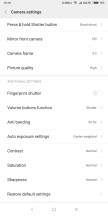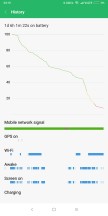Xiaomi Redmi Note 5 Pro hands-on review




Introduction
The Redmi Note 5 Pro is Xiaomi's latest smartphone, just recently introduced to the Indian market alongside the cheaper Redmi Note 5. While the company does sell more expensive models, the Redmi Note series has always been its best-selling and most important range
This year, the company has upped the ante significantly in terms of features, something the value conscious Asian markets are sure to find exciting.
We have a taller aspect ratio display, new cameras on the front and back, a powerful new processor, faster memory and the same big battery that the series has come to be known for. If the competition isn't already worried, it should be.
Xiaomi Redmi Note 5 Pro specs
- Body: Plastic + Aluminum
- Screen: 5.99-inch, 2160x1080 IPS LCD, 403 PPI
- Rear Camera: 12MP (1.25μm), f2.2, Sony IMX 486 PDAF primary, 5MP (1.12μm), f2.0, Samsung depth sensor; 1080p video
- Front Camera: 20MP (1.0μm), f2.2 Sony IMX 376, LED flash; 1080p video
- Chipset: 14nm Qualcomm Snapdragon 636, Kryo 260 (4x Cortex-A73 @ 1.8GHz + 4x Cortex-A53 @ 1.6GHz), Adreno 509
- Memory: 4/6GB LPDDR4X, 64GB eMMC 5.0 + microSD (up to 128GB)
- OS: Android 7.1.1; MIUI 9
- Battery: 4000mAh; Quick Charge 2.0
- Connectivity: Hybrid dual SIM (4G+3G), 4G VoLTE, dual-band Wi-Fi 802.11ac, Bluetooth 5.0, GPS/GLONASS/BeiDou, Wi-Fi Direct, FM Radio, IR blaster, microUSB, headphone jack
- Misc: Fingerprint sensor, face unlock (coming later)
As you can see, Xiaomi is clearly not messing around this year. The jump to a Snapdragon 636 alone puts it in a different league compared to its competition. It has also been paired with LPDDR4X memory, which is only seen in high-end devices. Lastly, the phone also has one of the best cameras Xiaomi has shipped on a phone.
We will be taking a deeper look at the device at a later date but for now, let's take a quick look at some of the features and general performance.
Design
The Redmi Note 5 Pro is markedly different in appearance from its predecessor, with a completely different body.
On the front is the new taller 18:9 display with curved corners. The bezels around the display aren't the thinnest around but they are definitely thinner than its predecessor.
Unfortunately, three out of the four color versions come with a white front panel, which has very prominent looking bezels that destroy any illusions of a bezel-less design the phone could have had. They aren't particularly noticeable while using the phone in portrait mode but become an eyesore while watching a video and you can tell precisely where the display ends and the bezels begin. If this is the sort of thing that will annoy you then the black model is your best bet.
Around the side, we have the power and volume control buttons on the right. The buttons are well placed and have an incredibly satisfying tactile response that is neither too soft nor too firm. On the opposite side is a hybrid SIM tray that sits flush and blends perfectly with the body.



The back of the phone looks rather familiar. If you cover up the camera for a second, it looks like almost any other recent Xiaomi phone. And if you look at the camera then, well, the inspiration is obvious. The camera module juts out considerably from the back; this makes the phone wobble on a hard surface.
Despite the minor annoyances, the design has evolved and has become more refined over the years. The glass on the front has a gentle curve around the edges and is now made out of Corning Gorilla Glass. The metal sheet on the back has a greater curvature and feels more secure in hand. The metal also blends in with the plastic bits at the top and bottom better, with improved color matching and tighter tolerances. All of these contribute to a design that feels a bit more opulent than any of the previous Redmi devices. It is still, however, a step down from true unibody aluminum designs and we would like to see Xiaomi go in that direction in the future.

Also, it's worth pointing out that this is a big and heavy phone. This phone is noticeably taller than its predecessor, so those with smaller hands are going to have an even harder time reaching the top of the screen. The weight has also gone up significantly and there is a considerable heft to this phone that might deter some buyers.
Display
The Redmi Note 5 Pro has a 5.99-inch, 2160x1080 IPS LCD with an 18:9 aspect ratio. The display has multiple settings to adjust the color, contrast and temperature. By default, it is set to Automatic mode, which automatically adjusts the contrast to ambient lighting. The Increased contrast mode locks it down to a high contrast and saturation setting with a cool color temperature. Or you can set it to the Standard mode, which has more normalized color, contrast and color temperature closer to sRGB values but not precisely so. If you want color accuracy, this is the mode to use, which is what we did on our unit.
We still wish Xiaomi followed the industry trend to provide standardized color presets for sRGB and DCI-P3 color spaces instead of arbitrary values but we were still happy with what we got out of the Standard mode.
In the Standard mode, image quality is excellent. This is down to the panel itself, which has wonderful colors, contrast and gets plenty bright (and plenty dark). The display is also very closely laminated to the glass on the surface, which makes the images that much livelier.
Software
The Redmi Note 5 Pro ships with Android 7.1.1 underneath MIUI 9. Our non-retail review unit came with 9.2.2.0 Nightly build, which we hope and assume isn't too different from the version that will ship with retail units later this week.
As is the case with MIUI devices, the software on the Redmi Note 5 Pro is more or less identical to what you get on other Xiaomi devices running MIUI 9. The differences are usually hardware specific and can be seen in things like the Camera app (which we will talk about later) but, by and large, the experience is similar. Basically, if you have used one MIUI 9 device, you have used them all.
So, we will skip the summary and talk about the general pros and cons. The pros include a lot of features and functionality built into the OS that you don't get in stock Android. Things like Dual apps (which lets you run two instances of a single app with different accounts), App lock, theme support, Second space (which creates a separate profile on the same phone), and Caller ID (which identifies some unknown numbers and also warns if enough people have reported it as spam).
Xiaomi also does a lot of localization, so you get features like a messaging app that can automatically detect SMS with train ticket info and presents it in a more readable format, ability to filter notification SMS into a separate folder and also an option to copy the OTP easily. There is also a video player built-in that could play everything we threw at it. All of these are useful additions that people have come to appreciate.
Unfortunately, MIUI still looks like something designed primarily for the Chinese market, and just like other Chinese ROMs out there, the iOS influence looms large. This means overuse of white everywhere in the UI, no app drawer and forced square borders around all the icons. Xiaomi also resolutely ignores many of the new UI features in the latest versions of Android; the notifications still cannot be expanded, many of the default apps still require you to press and hold the multitasking key to access the 'Menu' function (something that died in stock Android years ago), the share sheet is straight up ridiculous and you can't press and hold the app icons to access app shortcuts. This is just the tip of the iceberg and listing all the shortcomings in MIUI will require its own separate article.
Bottomline is, Xiaomi has done some good work to make MIUI more relevant and functional to its users. However, it is all built upon a somewhat outdated user interface that needs to be brought in line with Google's UI design guidelines, not Apple's.
Performance
The Redmi Note 5 Pro is the first smartphone to have Qualcomm's newest Snapdragon 636 processor. While the 600-series has largely been rather here nor there, things are now starting to look up a little. The reason for that is the inclusion of the semi-custom Kryo 260 CPU, which is a combination of 4x Cortex-A73 and 4x Cortex-A53 CPU cores from ARM. It's the A73 part that really excites us, as that is exactly what's found inside the more powerful Kryo 280 on the Snapdragon 835.
While last year's Redmi Note 4 was no slouch, it did lack some of oomph from the Snapdragon 650 running Redmi Note 3 and was more serviceable than exciting. But the Snapdragon 636 has us excited again, not just for the Redmi Note 5 Pro but for all the mid-range devices that will be shipping with it in future.
Using the Redmi Note 5 Pro for a while reassured us that our excitement was well grounded. The performance on this device is a noticeably improved over its predecessor and genuinely good for most parts. There were times when someone could have told us there was a Snapdragon 835 inside and we would have believed with little hesitation. Other times, you do see some hitches while scrolling or opening apps but this could easily be fixed with some more optimization down the line.
Some of the credit for the performance likely also goes to the use of the more expensive LPDDR4X memory, which is an inspired choice, especially at a time when memory prices worldwide have gone up considerably.
Graphics performance has also seen a small improvement over its predecessor. It's not quite the same leap we saw over on the CPU side but the GPU is now powerful enough to play almost every game you throw at it perfectly fine. The device also maintains its temperature quite well during gaming and we didn't notice any undue heating.
We tried running our usual suite of benchmarks but for some reason, a lot of them refused to run on our test unit, so we only have limited results available at the moment.
Camera
The Redmi Note 5 Pro has a dual camera system on the back, with a 12MP primary sensor and a 5MP secondary depth sensor. This is the first Redmi Note device to have a dual camera system on the back. On the front is a single 20MP camera with an LED flash.
The camera application is similar to other MIUI 9 devices but has been updated to include the option for portrait mode. All the options are laid out at the bottom similar to the iOS camera app. At the top you can enable the HDR mode, which has no Auto mode for the rear camera (but has for the front camera somehow) and a filter mode with a bunch of new filters.
The camera app on the Redmi phones continue to be behind the Mi series devices. The lack of HDR Auto mode is one thing but the pro mode also only has white balance and ISO adjustment instead of the full range of options. Still, for casual shooting the app works reasonably well.
Now, coming to the image quality, we were genuinely impressed with the images in well-lit situations. Xiaomi's image processing is really good and even when the images are looked up close there is very little in terms of compression artefacts, oversharpening artefacts and color noise.
The images look beautifully smooth even when viewed at 100% zoom and this is without sacrificing a lot of image detail. The camera consistently nailed the color and white balance and every image came out looking just as we had expected.
Xiaomi is also one of the few companies to get HDR processing right. Enabling HDR pulls details out of both, shadows as well as highlights unlike most other devices that only prioritize the shadows. We were impressed at the level of detail the HDR mode was able to pull out of some images.
Low light image quality was also respectable. Noise levels were still perfectly in control and it is only in really low light do the images turn soft. Color and white balance were once again right every time. This is no Pixel 2 or iPhone X in low-light but it can hold its own, especially against the immediate competition.
The portrait mode also worked better than expected. Edge detection was generally quite good and whether it was with people or objects, the camera did a good job separating the background from the foreground. The blur effect isn't as heavy-handed as some of the other phones, which is fine as it makes the blur look more natural but, in some cases, may not be especially noticeable.
Video recording experience was less impressive. The phone has no support for 4K recording, even though the chipset is capable of doing it and other phones in this price range are doing it with much slower processors.
The viewfinder output is also extremely low resolution, which makes it hard to tell if the camera has even focused while you are recording and you have to play the video back afterwards to see if it was in focus.
The actual image quality is okay but nothing especially good, with soft details and weak dynamic range. The electronic image stabilization is good but has the characteristic jerkiness when you pan the camera around.
CLICK HERE TO SEE CAMERA QUALITY
Battery Life
Within our brief testing, the battery life on the Redmi Note 5 Pro was just as impressive as we expected it to be. We consistently got around 8 hours of screen-on time with one full day of usage. Less demanding users will be able to make the phone last for two days but even if you wring the life out of it you can still expect it to last you an entire day with ease.
The charging experience was less stellar. The phone supports only Quick Charge 2.0 even though the chipset should theoretically support up to Quick Charge 4.0.
The phone also ships without a fast charger in the box. Even if you were to get a fast charger of your own, there are no advantages of doing so as in our testing, the charging times with a 10W standard charger and a 15W QC 3.0 charger were identical, with 30 minutes of charging giving you about 27% of charge and 60 minutes of charging giving 55% of charge.
A full charge from 0% takes about 2 hours 20 minutes. This is not a phone you charge in a hurry. The microUSB connector adds further insult to injury. It's high time manufacturers make the jump to USB-C for good.
Conclusion
In our week with the device, we were generally impressed with the Redmi Note 5 Pro. Xiaomi likes to call the Redmi Note series an 'all-rounder' and it has never been truer before. A quality display, an excellent performance from a new processor, fabulous cameras and the same incredible battery life, the new Redmi Note 5 Pro delivers on nearly every count. While the budget segment has always been about making compromises, we really don't see a lot that was sacrificed here in order to achieve these great results, which makes the highly competitive pricing even more outstanding.
The only area we wish Xiaomi would improve is in software. MIUI was really cool back when Android looked like something you'll would find on an ATM today but it's not 2012 anymore and we don't even particularly like seeing the iOS UI on iPhones, let alone Android phones. The company needs to rethink its software design strategy and align itself with modern Android design guidelines, current industry trends as well as the tastes and expectations of users outside of China.
Apart from that, however, we didn't have much to complain about this phone. There will be a full review at some point but if you wanted a quick answer to whether or not you should buy this phone, then the answer is yes. If you bought a Redmi Note 4 last year, then you can probably skip this year but if you're still holding onto a Redmi Note 3 then this would be a good time to upgrade.
As for the competition, we like the look of the Honor 9 Lite but the Redmi Note 5 Pro has a leg up in some key areas such as camera and battery life and as such would be our pick of the two. What we would personally like to see is an Android One version of this phone, but we wouldn't be holding our breath for that.
KEY SPECIFICATIONS
LAUNCH | Announced | 2018, February |
|---|---|---|
| Status | Available. Released 2018, February |
| BODY | Dimensions | 158.6 x 75.4 x 8.1 mm (6.24 x 2.97 x 0.32 in) |
|---|---|---|
| Weight | 181 g (6.38 oz) | |
| Build | Front glass, aluminum body | |
| SIM | Hybrid Dual SIM (Nano-SIM, dual stand-by) |
| DISPLAY | Type | IPS LCD capacitive touchscreen, 16M colors |
|---|---|---|
| Size | 5.99 inches, 92.6 cm2 (~77.4% screen-to-body ratio) | |
| Resolution | 1080 x 2160 pixels, 18:9 ratio (~403 ppi density) | |
| Multitouch | Yes | |
| Protection | Corning Gorilla Glass (unspecified version) | |
| - MIUI 10 |
| PLATFORM | OS | Android 7.1.2 (Nougat), upgradable to Android 8.1 (Oreo) |
|---|---|---|
| Chipset | Qualcomm SDM636 Snapdragon 636 (14 nm) | |
| CPU | Octa-core 1.8 GHz Kryo 260 | |
| GPU | Adreno 509 |
| MEMORY | Card slot | microSD, up to 256 GB (uses SIM 2 slot) |
|---|---|---|
| Internal | 64 GB, 4/6 GB RAM |
| MAIN CAMERA | Dual | 12 MP, f/2.2, 1.25µm, PDAF 5 MP, f/2.0, 1.12µm, depth sensor |
|---|---|---|
| Features | Dual-LED flash, panorama, HDR | |
| Video | 1080p@30fps |
| SELFIE CAMERA | Single | 20 MP, f/2.2, 1/2.8", 1.0µm |
|---|---|---|
| Features | LED flash | |
| Video | 1080p@30fps |
| SOUND | Alert types | Vibration; MP3, WAV ringtones |
|---|---|---|
| Loudspeaker | Yes | |
| 3.5mm jack | Yes | |
| - Active noise cancellation with dedicated mic |
| COMMS | WLAN | Wi-Fi 802.11 a/b/g/n/ac, dual-band, WiFi Direct, hotspot |
|---|---|---|
| Bluetooth | 5.0, A2DP, LE | |
| GPS | Yes, with A-GPS, GLONASS, BDS | |
| Infrared port | Yes | |
| Radio | FM radio | |
| USB | microUSB 2.0 |
| FEATURES | Sensors | Fingerprint (rear-mounted), accelerometer, gyro, proximity, compass |
|---|---|---|
| Messaging | SMS(threaded view), MMS, Email, Push Email, IM | |
| Browser | HTML5 | |
| - Fast battery charging (Quick Charge 2.0) - DivX/Xvid/MP4/H.265 player - MP3/WAV/eAAC+/FLAC player - Photo/video editor - Document viewer |
| BATTERY | Non-removable Li-Po 4000 mAh battery |
|---|
| MISC | Colors | Black, Champagne Gold, Rose Gold, Lake Blue |
|---|---|---|
| SAR | 1.19 W/kg (head) 0.33 W/kg (body) | |
| Price | About 180 EUR |
CLICK HERE TO PLAY TUTORIAL
CLICK HERE TO BUY ONLNE
- OnePlus 5T67
- 01
- Xiaomi Redmi Note 5 Pro4696
- Samsung Galaxy A8 (2018)4418
- Moto G5S Plus4193
- Asus Zenfone 4 ZE554KL4145
- HTC U11 Life4140
- Motorola Moto X44136
- Sharp AQUOS S24046
- Huawei Honor 7X3535
- LG Q62244
XIAOMI MI NOTE 5 PRO
 Reviewed by kirat kumar
on
October 18, 2018
Rating:
Reviewed by kirat kumar
on
October 18, 2018
Rating:
 Reviewed by kirat kumar
on
October 18, 2018
Rating:
Reviewed by kirat kumar
on
October 18, 2018
Rating:





































No comments: